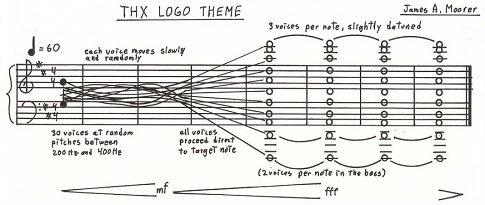Recreating the THX "Deep Note" in JavaScript
In this blog post, I’ll share how I recreated the iconic THX “Deep Note” using JavaScript and the Tone.js library.
Try it out. (Best with headphones. If you’re on mobile, be sure to unmute):
Tone.js
Tone.js is a powerful framework for creating interactive music in the browser. It provides an elegant API for dealing with audio signals, synthesizers, effects, and more. It is easier to work with than the Web Audio API, allowing us to focus on the creative aspects of audio programming.
Defining the “Deep Note”
The “Deep Note” is characterized by its unique crescendo effect, starting from a chaotic blend of tones that gradually converge into a harmonious chord. To achieve this, we define a set of notes that form a D Major chord, which will serve as our target harmony.
const NOTES = [
'D0',
'D1',
'A1',
'D2',
'A2',
'D3',
'A3',
'D4',
'A4',
'D5',
'F#5',
]I took these notes from the sheet music for the “Deep Note” (wikipedia):

The Sound Engine
The core of our implementation lies in creating audio nodes for each note in our chord.
The sheet music specifies that each note start on a random frequency between 200 and 400 Hz and ramps to its target frequency:
const frequencies = NOTES.map((note) => ({
// Random note between G3 and G4
start: getRandomInt(200, 400),
end: Tone.Frequency(note).toFrequency(),
}))We now have our frequency ranges for each note in the chord, and we can create the audio nodes:
frequencies.forEach((freq) => {
// Create a synthesizer with a "fatsawtooth"
// oscillator for that rich, full sound.
const sawtoothSynth = new Tone.Synth({
oscillator: {
type: 'fatsawtooth',
},
envelope: {
attack: 3,
decay: 0.8,
sustain: 1.0,
release: 2.0,
},
// Randomly detune the oscillator to give it a more analog sound
detune: getRandomInt(-2, 2),
})
// Apply a vibrato effect for a slight oscillation in pitch,
// adding to the richness of the sound.
const vib = new Tone.Vibrato(freq.end, 0.1)
// Use a gain node to control the volume.
const gain = new Tone.Gain()
// Add a reverb effect for spatial depth.
const reverb = new Tone.Reverb(1)
// Add a low pass filter to cut off the high frequencies.
// Frequencies above 11,000 Hz will be gradually reduced in volume,
// creating a smoother and less harsh sound
// by removing high-frequency noise or harshness from the output audio
const filter = new Tone.Filter(11000, 'lowpass', -12)
// Create an envelope to control the frequency
// and gain of the synthesizer.
// This is the source of the sweeping sound
// that is characteristic of the THX Deep Note.
const envelope = new Tone.Envelope({
attack: 10,
decay: 9,
sustain: 1.0,
release: 0.0,
})
// Normalize the frequency and gain values to the desired range
// This allows the envelope to control the frequency and gain of the synthesizer
const freqScale = new Tone.Scale(freq.start, freq.end)
const gainScale = new Tone.Scale(0.05, 0.7)
// Connect the synthesizer to the gain node, vibrato, reverb, and filter
sawtoothSynth.connect(gain)
gain.connect(vib)
vib.connect(reverb)
reverb.connect(filter)
// Connect the envelope to the frequency and gain scales
envelope.connect(freqScale)
envelope.connect(gainScale)
freqScale.connect(sawtoothSynth.frequency)
gainScale.connect(gain.gain)
// Connect the filter to the main output
filter.toDestination()
// Start the synthesizer
sawtoothSynth.triggerAttackRelease(freq.start, 16)
// Start the envelope
envelope.triggerAttackRelease(5)
})Source Code
The full source can be found here.
Conclusion
Recreating the THX “Deep Note” in JavaScript was a fun challenge. I’d like to try visualizing the sound, perhaps using WebGL or Three.js to create a dynamic audio-visual experience.
If you have any feedback, please reach out to me on Twitter/X.
